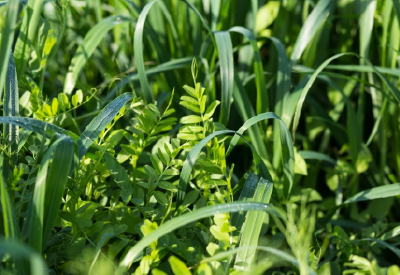For many of us, it’s the end of the growing season. While you may be squirreling away food to preserve the season’s harvest, your soil may feel like it just participated in a marathon…because, in its fruit-bearing way, it did.
As the plants you've grown come to an end, the soil provides the foundation for the next cycle. One way to help improve soil health and prepare your land for the next growing season is through the use of cover crops.
What is a Cover Crop?
A cover crop is a natural technique for replenishing depleted soil and sustainably improving its overall health. It involves planting crops not harvested in the off-season between the main crop cycles, either during the fallow period or alongside the primary crop.
Why are Cover Crops Important?
Since soil will lose topsoil and likely settle after a growing season, covering crops is a natural and sustainable way to bring the soil back to life. Cover crops offer a range of valuable benefits to the land, including:
- Enhancing organic matter levels
- Boosting plant biodiversity
- Improving water retention capacity
- Reducing soil erosion
- Reduce nitrogen leaching into groundwater
- Provide a “green manure” when incorporated into the soil before the next planting season
- Promote the growth of beneficial microorganisms
- Enhance nutrient cycling
- Suppress weeds
Selecting Suitable Cover Crops
When selecting cover crops, choosing species well-suited to your local climate and growing conditions that fit your objectives is important. Some common cover crop options include:
Legumes
Legumes are great for fixing nitrogen. Nitrogen fixation is when atmospheric nitrogen (N2) is converted into usable compounds. Legumes' relationship with Rhizobium bacteria makes this possible. See the Nitrogen Cycle for more information. Hairy vetch, crimson clover, and winter peas are some examples of nitrogen-fixing legumes.
Non-legumes
Non-legumes like grasses, grains, and brassicas create more organic matter than legumes and are most useful for scavenging nutrients. When NPK fertilizers are overused, runoff from fields can become nutrient-polluted, otherwise known as eutrophication. Non-legumes are great, as they help clean up excess nutrients.

Maximizing the Benefits of Cover Crops
The timing of planting your cover crop is important because it affects the organic matter that’s turned over and the amount of N that gets released into the soil.
To get the most out of your cover crops, consider the following:
- To determine ideal planting and termination windows, reference local frost dates in the farmer’s almanac or other regional resources.
- The farmer’s almanac also provides useful information about selecting suitable crops specific to your growing zone. Check out this cover crop list for ideas for your soil.
- Experiment with cover crop mixtures to promote biodiversity and enhance benefits.
- Terminate cover crops 2-4 weeks before planting the next crop to allow enough time for the cover crop to decompose and release nutrients.
- Test your soil to see what micro and macronutrients are lacking and what bioavailable nutrients currently exist in your soil, and track how your soil improves over time.
Building Soil vs Fertilizing Dirt
Plants deeply intertwine with the living and decaying life surrounding them. When fed only synthetic nitrogen, phosphorus, and potassium (NPK fertilizers), they lose this natural connection, becoming dependent on artificial nutrients year after year. Redmond believes Nature Has it Right™. Microbe rich soil sustains the nitrogen and carbon cycles and nurtures healthy plants. This, in turn, fosters the growth of more resilient, nutrient-dense plants that make for healthier animals and people. It all starts with building soil.
Building Healthy Soil with Redmond
Cover crops are a natural and sustainable way to look beyond NPK and replenish the full breadth of nutrients required to grow resilient, nutrient-dense plants and build a healthier ecosystem. Consider adding a mineral supplement like Mineralyte to support your soil's lifeblood further. With a full spectrum of sea minerals, our soil amendments can improve electrical conductivity (EC) levels. Electrical conductivity indicates the total dissolved ions and other charged particles in the soil solution; these ions act as a current. Like a highway system, the EC current transfers nutrients through the soil, stimulating microbe activity. These trace minerals also provide your plants with the building blocks they need to utilize nitrogen.
You’ve got another natural and sustainable growing method in your toolbelt. By incorporating cover crops into your growing season, you can build soil fertility and improve overall soil health - leading to greater productivity and sustainability for years to come. Happy planting!
Give Redmond a call today at  to see how we can help your garden grow.
to see how we can help your garden grow.
© 2024 Redmond Minerals Inc.

